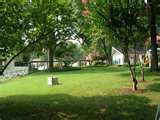
You do everything right. You water, fertilize and mow with a methodical approach yet you find these circular yellow spots on you lawn. More than likely you have cinch bugs.
These nasty things will eat away at your grass sucking the juice right out of it then leave behind a poison that kills. They are most common in the South, East and Midwest. They love St. Augustine grass, Kentucky Bluegrass and Bent grass. They also like highly fertilized grass, and this is another reason I say too much fertilizing can be harmful.
Well, here's a way you can test and verify if these pests have invaded. Take a teaspoon of liquid detergent, dish or laundry, and mix it with a quart of water. Then remove both ends of a tin can to make a tin tube. Push one end of the tin tube into the ground, about 2-3 inches. Then pour about 1 cup of the solution into the can. Wait about 5-10 minutes and watch for anything climbing or floating to the surface. You may be surprised at what you see coming up.
They tend to infest when there is a thick thatch, poor nitrogen content and lack of water. They usually appear during dry spells. They'll colonize in the hottest and driest parts of your lawn. It may be difficult to distinguish drought damage from cinch bugs, but the "can" test will tell the tale.
There's a simple, cheap and very effective home remedy for removing cinch bugs. In the Pest Control Pages at The Little Green Apple.com I have provided a modest recipe for insecticidal soap. In the mid-section of the "Yellow patches in my lawn" article there's a cinch bug home remedy removal procedure that will allow you to rid yourself of these suckers. It's cheap, quick and effective. If you choose to do this procedure you'll want to grab the kids and gather the neighbors because it's quite entertaining.
You can also try Scott's Bug-B-Gone insect killer for lawns that will work great; just follow the instructions.
As another option, and if you're wanting to use what's around the house and relatively less expensive, make the insecticidal soap I mentioned above and add 4 teaspoons of isopropyl rubbing alcohol. Pour it into a spray bottle that you have labeled explicitly and spray the infected areas every 3 days for 2 weeks. This should take care of the little pests.
Taking preventative measures is always the best way to keep them out. To do so make sure your thatch layer never gets any thicker than 1/4 inch, keep your lawn moist and well watered and try to avoid over fertilizing.
|
|
